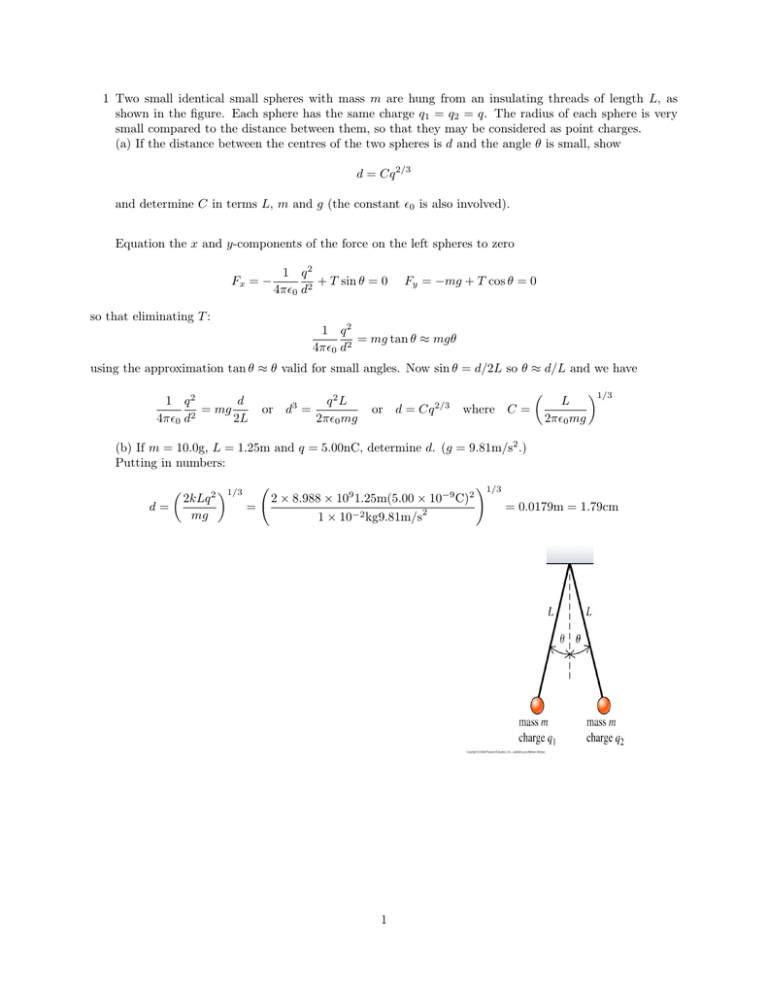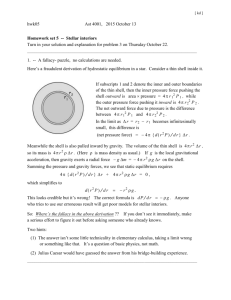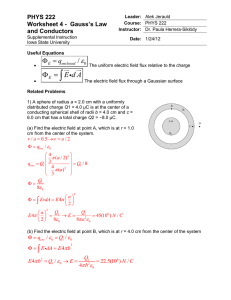2 A small
advertisement

1 Two small identical small spheres with mass m are hung from an insulating threads of length L, as shown in the figure. Each sphere has the same charge q1 = q2 = q. The radius of each sphere is very small compared to the distance between them, so that they may be considered as point charges. (a) If the distance between the centres of the two spheres is d and the angle θ is small, show d = Cq 2/3 and determine C in terms L, m and g (the constant 0 is also involved). Equation the x and y-components of the force on the left spheres to zero Fx = − 1 q2 + T sin θ = 0 4π0 d2 Fy = −mg + T cos θ = 0 so that eliminating T : 1 q2 = mg tan θ ≈ mgθ 4π0 d2 using the approximation tan θ ≈ θ valid for small angles. Now sin θ = d/2L so θ ≈ d/L and we have d 1 q2 = mg 2 4π0 d 2L q2 L or d = 2π0 mg 3 or d = Cq 2/3 where C= L 2π0 mg 1/3 (b) If m = 10.0g, L = 1.25m and q = 5.00nC, determine d. (g = 9.81m/s2 .) Putting in numbers: d= 2kLq 2 mg 1/3 = 2 × 8.988 × 109 1.25m(5.00 × 10−9 C)2 1 × 10−2 kg9.81m/s 1 2 !1/3 = 0.0179m = 1.79cm 2 A small conducting spherical shell with inner radius a and outer radius b is concentric with a larger conducting spherical shell with inner radius c and outer radius d. The inner shell has a total charge +2q, and the outer shell has a charge +4q. (a) Calculate the electric field in terms of q and the distance r from the common centre of the two shells. i For r < a apply Gauss’s law for a sphere radius r: I I I Qenc ~ ~ E · dA = E · dA = E ·dA = e4πr2 = =0 0 since there is not enclosed charge. So E = 0. ii Now for a < r < b, E = 0 since inside a conductor. iii For b < r < c I ~ · dA ~ = E4πr2 = Qenc = 1 2q E 0 0 so that E = 1 2q . 4π0 r2 iv For c < r < d, E = 0 since inside a conductor. v d<r<e I ~ · dA ~ = E4πr2 = Qenc = 1 (2q + 4q) E 0 0 so that E = 1 6q . 4π0 r2 Graph the result for the magnitude E as a function of r. (b) What is the total charge on the i inner surface of the small shell q1 = 0 since otherwise would have E 6= 0 in inner conductor. ii outer surface of the small shell q2 = 2q - is total charge. iii inner surface of the large shell q3 = −2q since otherwise would have E 6= 0 in outer conductor. iv outer surface of the q3 = 4q so total on outer is 4q. large shell 2 3 (a) An electric charge Q is distributed uniformly around a ring of radius a. The rimg lies in the y − z-plane with the origin at its centre. Find the potential V (x) at a point P on the ring axis at a distance x from the centre of the ring. (Assume the potential V = 0 at infinity.) Take a small piece ds on ring. Its charge is dq = (Q/2πa)ds and produces a contribution 1 dq Q 1 ds √ = 2 4π0 r 2πa 4π0 r + x2 dV = Then for the total potential Z Z Q 1 Q 1 1 1 1 Q √ √ √ V = dV = ds = 2πa = 2πa 4π0 a2 + x2 2πa 4π0 a2 + x2 4π0 a2 + x2 (b) A disk with radius R has a positive uniform surface charge density σ and lies in the y − z-plane with the origin at its centre. Divide the disk into a set of concentric rings and use the result of (a) to calculate the electric potential, also at a distance x from the centre. Show, for x > 0, the potential V (x) = σ p 2 ( x + R2 − x). 20 (You should get an integral you know how to do!) Cut out a ring between a and a + da. This has and area 2πada and hence a charge (Q/πR2 )2πada = (2Q/R2 )ada. Using the above, which now becomes an infinitensimal dV = 1 Q 2ada √ 4π0 R2 a2 + x2 and Z V = 2 dV = 1 Q 4π0 R2 Z R √ 0 2ada a2 + x2 2 To do the integral, write z = a + x so that dz = 2ada whence Z 0 R √ 2ada = a2 + x2 Z R2 +x2 x2 p p √ √ R+ x2 dz √ = 2 z x2 = 2( R2 + x2 − x2 ) = 2( R2 + x2 − x) z assuming x is positive. Then since 1 Q σ = 2 4π0 R 40 the required result follows. ~ lies in positive x-direction. Use the result of (b) to show the (c) By symmetry, the electric field E magnitude E = σ/20 when R x. Have E = Ex = − ∂V σ ∂ p 2 σ x σ x σ =− ( x + R2 − x) = − (√ − 1) ≈ − ( − 1) ≈ ∂x 20 ∂x 20 20 R 20 x2 + R2 as expected when R x! 3



